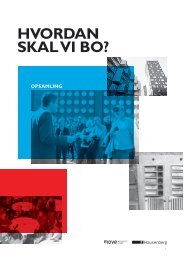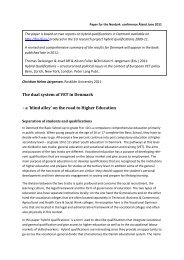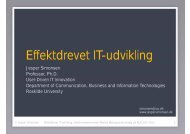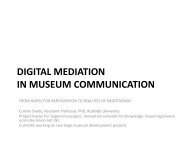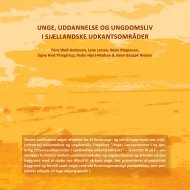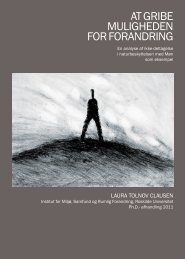Abstractbog printer - ansatte - Roskilde Universitet
Abstractbog printer - ansatte - Roskilde Universitet
Abstractbog printer - ansatte - Roskilde Universitet
You also want an ePaper? Increase the reach of your titles
YUMPU automatically turns print PDFs into web optimized ePapers that Google loves.
Abstracts - S2 Nye & automatiske måleteknikker i havforskning<br />
11. Acoustic Telemetry: Harbour porpoises and seals<br />
Jonas Teilmann 1 , Rune Dietz 1 , Peter T. Madsen 2 , Danuta Wisniewska 2 , Mark Johnson 3 , Lee A.<br />
Miller 4 (presenter), Ursula Siebert 5<br />
1<br />
Institut for Bioscience, Aarhus <strong>Universitet</strong> jte@dmu.dk, rdi@dmu.dk<br />
2<br />
Institut for Bioscience, Aarhus <strong>Universitet</strong>, Ny Munkegade 116, 8000 Aarhus C<br />
peter.madsen@biology.au.dk, biodmw@biology.au.dk<br />
3<br />
SMRU, Scottish Oceans Institute, University of St Andrews, St Andrews, Fife, KY16 8LB, UK<br />
markjohnson@st-andrews.ac.uk<br />
4<br />
Biologisk Institut, Syddansk <strong>Universitet</strong>, Campusvej 55, 5230 Odense M lee@biology.sdu.dk<br />
5<br />
Stiftung Tierärztliche Hochschule Hannover, Bünteweg 2, 30559 Hannover, Tyskland<br />
ursula.siebert@tiho-hannover.de<br />
The German Bundesamt für Naturschutz (BfN) finances an extensive environmental impact<br />
initiative in connection with the establishment of offshore wind turbine parks. One of the programs<br />
involves underwater sound, the head of which is Prof. Ursula Siebert. The Institute of Bioscience<br />
(AU), and The Sea Mammal Research Unit (SMRU) have responsibility for developing and<br />
constructing a behavioral tag, to deploy tags on harbour porpoises and harbour seals, and to<br />
evaluate the responses of the tagged animals to the acoustic environment. The prototype of the<br />
archival tag (Dtag3) contains two hydrophones and electronics to provide an acoustic bandwidth<br />
from 50 Hz to 160 kHz thus covering the full auditory range of both harbour porpoises and harbour<br />
seals. Since the hydrophones are calibrated, the level of received sound can be measured. In<br />
addition to monitoring the acoustic behavior of the tagged animal in response to extraneous sound,<br />
movements can be monitored by a tri-axial accelerometer and dive depth can be measured. In the<br />
final version of the tag a GPS position will be acquired (in 50 ms) each time the animal surfaces.<br />
Four suction cups hold the tag on the porpoise and when the suction is released the tag floats to the<br />
surface where an Argos satellite transmitter and a VHF radio start transmitting. The Argos system<br />
determines the general position of the tag within 30 min and the radio signal assists finding the tag<br />
at close range. The prototype Dtag3 has recently been attached to two harbor porpoises in the<br />
waters off Djursland on two separate occasions, in the first case the recording time was 22 h and in<br />
the second 18 h. Dive behavior of the second animal is shown in the figure. Feeding attempts, as<br />
indicated by “buzzes” in the acoustic signal, were heard from both tagged animals. A young<br />
individual, presumably an offspring, accompanied the second tagged animal, and feeding attempts<br />
could be heard by this individual also. Echoes from objects (probably prey) could also be recorded.<br />
Ship noise was obvious. Details of the recordings await analysis, but the conclusion is that the<br />
proto-type Dtag3 tested successfully and the project will certainly provide valuable information<br />
concerning the effects of anthropogenic sounds on harbour porpoises and seals during deployments<br />
in 2013-14.<br />
The figure shows the full 18 hr dive profile of a<br />
harbor porpoise carrying an archival tag (Dtag3). It<br />
dove to a maximum depth of 30 m in the Kattegat.<br />
The dive behavior appears quite normal as<br />
compared to that of other porpoises tagged with<br />
another system.<br />
Major funding for the Underwater Sound program from BfN. Additional funding from AU.<br />
Program 17. danske havforskermøde, 31





